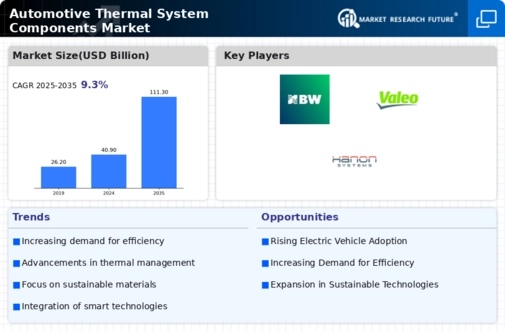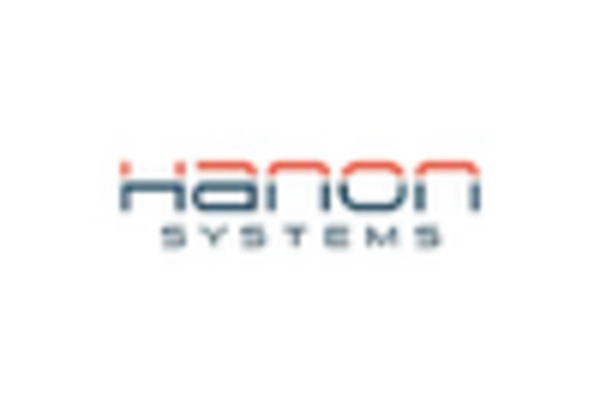Increasing Demand for Fuel Efficiency
The Automotive Thermal System Components Market is experiencing a notable surge in demand for fuel-efficient vehicles. As consumers become more environmentally conscious, manufacturers are compelled to enhance thermal management systems to optimize engine performance and reduce emissions. This trend is underscored by regulatory pressures aimed at lowering carbon footprints. In 2025, the average fuel economy standards are projected to rise, prompting automakers to invest in advanced thermal systems. These systems not only improve fuel efficiency but also contribute to overall vehicle performance, making them a focal point in automotive design. Consequently, the demand for innovative thermal components is likely to escalate, driving growth in the Automotive Thermal System Components Market.
Growth of Electric and Hybrid Vehicles
The proliferation of electric and hybrid vehicles is a pivotal driver for the Automotive Thermal System Components Market. As these vehicles gain traction, the need for effective thermal management systems becomes increasingly critical. Electric vehicles, in particular, require advanced cooling solutions to maintain optimal battery temperatures and ensure performance efficiency. The market for electric vehicles is projected to expand significantly, with estimates suggesting that by 2025, electric and hybrid vehicles could account for over 30% of total vehicle sales. This shift necessitates the development of specialized thermal components, thereby stimulating growth within the Automotive Thermal System Components Market.
Regulatory Compliance and Emission Standards
The Automotive Thermal System Components Market is significantly influenced by stringent regulatory compliance and emission standards. Governments worldwide are implementing rigorous regulations to curb greenhouse gas emissions, compelling manufacturers to adopt advanced thermal management solutions. In 2025, it is anticipated that new emission standards will be enforced, necessitating the incorporation of efficient thermal systems in vehicle designs. This regulatory landscape not only drives innovation but also creates a competitive advantage for companies that can swiftly adapt to these changes. As a result, the demand for high-performance thermal components is expected to rise, further propelling the growth of the Automotive Thermal System Components Market.
Technological Advancements in Thermal Management
Technological innovations are reshaping the Automotive Thermal System Components Market. The integration of advanced materials and smart technologies is enhancing the efficiency of thermal systems. For instance, the adoption of phase change materials and heat exchangers is becoming more prevalent, allowing for better heat dissipation and management. Furthermore, the rise of electric vehicles necessitates sophisticated thermal management solutions to maintain battery performance and longevity. As a result, the market for thermal system components is projected to grow at a compound annual growth rate of approximately 6% through 2025. This growth is indicative of the industry's response to evolving technological demands and the need for improved thermal efficiency.
Consumer Preference for Advanced Comfort Features
Consumer preferences are evolving towards vehicles equipped with advanced comfort features, which is influencing the Automotive Thermal System Components Market. Features such as climate control systems, heated seats, and advanced air conditioning are becoming standard expectations among consumers. This trend is prompting manufacturers to invest in high-quality thermal management systems that enhance passenger comfort. As of 2025, it is estimated that the market for automotive climate control systems will witness a growth rate of around 5% annually. This increasing demand for comfort-oriented features is likely to drive innovation and expansion within the Automotive Thermal System Components Market.

















Leave a Comment